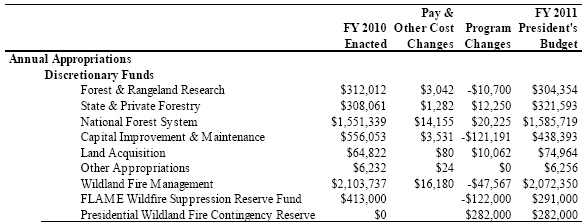The President of the United States has released the administration’s proposed budget for fiscal year 2011 which begins October 1, 2010. One of the big changes that will affect wildfire management is that in addition to the FLAME Act wildfire suppression reserve fund, in FY2011 there will also be a “Presidential Wildland Fire Contingency Reserve Fund” of $282 million for the U.S. Forest Service and $75 million for the four Department of Interior wildfire agencies: the National Park Service, Fish and Wildlife Service, Bureau of Indian Affairs, and the Bureau of Land Management. The Presidential Wildland Fire Contingency Reserve Fund is to be used after the fully funded, inflation-adjusted 10-year average of suppression costs is exhausted.
Keep in mind that the President’s proposed budget will almost certainly be modified by Congress.
Below, are the details for the Department of Interior and the USFS.
Department of Interior (from the Department of Interior web site):
The 2010 budget request for Wildland Fire Management totals $933.9 million, an increase of $78.0 million over the 2010 enacted level, which did not fully fund the ten-year suppression average.
The 2011 budget request provides sufficient funding for wildland fire suppression to minimize the need for transferring funds from non-fire accounts, and also emphasizes budget transparency. The 2011 budget allocates suppression funding among three accounts. The ten-year average of $384.0 million is split between $288.0 million in the regular suppression account in the Wildland Fire Management appropriation and $96.0 million in the FLAME Wildfire Suppression Reserve Fund that was authorized by Congress in Title V of the 2010 Interior Appropriations Act. Consistent with the FLAME Act, the regular suppression account will fund initial attack and predictable firefighting costs, while the FLAME Fund will fund the costs of large catastrophic-type fires and also serve as a reserve when funds available in the regular suppression account are exhausted.
In the event that suppression needs exceed the ten-year average, the 2011 budget request also includes a $75.0 million Presidential Wildland Fire Contingency Reserve. This contingency reserve helps ensure that sufficient funds are available for suppression activities. It cannot be tapped until all suppression funds have been depleted and the President issues a finding that the amounts are necessary for emergency suppression operations.
In total, the 2011 request for suppression for all three accounts is $459.0 million, an increase of $139.2 million over the 2010 enacted level. The budget proposes to reduce funding for Hazardous Fuels Reduction by $42.6 million. The Department will apply the funding decrease for the fuels program to treatments outside of the wildland-urban interface. The budget request gives greater priority to reducing the risk of wildfire to communities by increasing the proportion of fuels funding spent on treatments in the wildland-urban interface. The budget also proposes to discontinue the $7.0 million in funding for the Rural Fire Assistance program , reduces funding for Preparedness by $5.0 million and funding for Burned Area Rehabilitation by $2.0 million.
U.S. Forest Service (from the USFS web site):
This budget request continues to support the Presidential Initiative from FY 2010 to responsibly budget for wildfire by proposing a three-tiered system for wildland fire attack. The request includes a request of $886 million to fully fund suppression costs. Costs are split into $595 million to fund the Suppression account, and $291 million to fund the new FLAME Act Fund. FLAME Act Funds will be available to the Secretary of Agriculture to be transferred into the Suppression account when the Suppression account is nearly exhausted and/or certain objective criteria are met as fires escape initial response.
In recognition that $886 million may not be sufficient if the fire season is particularly long or severe, a $282 million discretionary Presidential Wildland Fire Contingency Reserve for fighting catastrophic wildfires is also proposed. Funds in the Contingency Reserve would be in a separate Treasury account, available to the Forest Service subject to depletion of the Suppression account and FLAME Act Fund, and after the issuance of a Presidential finding that the funds are necessary. This three-tiered system will provide adequate funding for fire suppression and allow for other critical Forest Service activities to continue while reducing the likelihood of disruptive transfers from non-fire accounts.
This budget request also properly realigns Preparedness and Suppression funding by shifting funds from the Suppression account into Preparedness. This shift is based on a realignment of the costs that have been shifted into the Suppression account during the past 6 years; FY 2005 – FY 2010. These program readiness costs have been shifted back into the Preparedness account resulting in an increased Preparedness request and a decreased Suppression request with no net change in resource availability from FY 2010. This ensures that preparedness costs are fully identified and separate from the costs of fire suppression.
In FY 2011, the Forest Service proposes $349 million to reduce hazardous fuels on approximately 1.6 million acres of national forest and adjacent lands, focusing on treating acres in the wildland urban interface (WUI), with Community Wildfire Protection Plans (CWPPs) identifying areas to be treated. The strategy of focusing on high priority fuels within the WUI will help deter large, destructive, and costly wildfires, thereby protecting communities invested in implementing local solutions to protection against fire, reducing safety risks to firefighters and the public and reducing wildfire suppression costs. In FY 2011, all Hazardous Fuels funds will be allocated to the regions using a newly modified Hazardous Fuels Prioritization Allocation System (HFPAS), which will rank and prioritize hazardous fuels projects nationally. Prioritizations will be based on factors such as fire potential, values at risk, efficiency of treatments, and effectiveness of treatments with an emphasis and focus on WUI.
[In the table below, the numbers are in thousands; add “000” to each one.]

